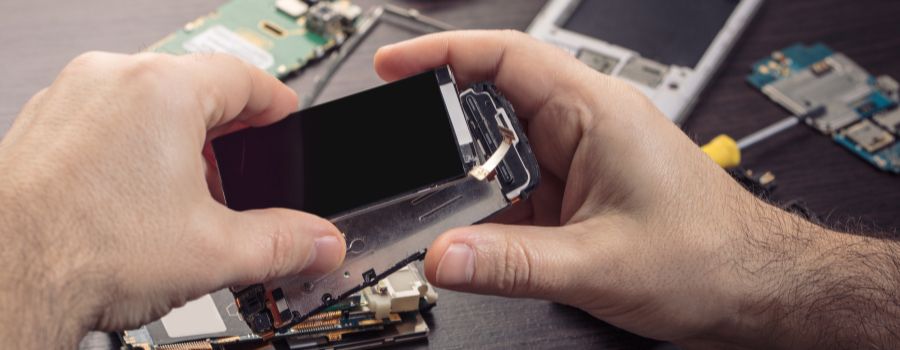
In today's fast-paced digital age, our mobile devices serve as our lifelines, connecting us to the world and facilitating our daily tasks. However, with this heavy reliance on our smartphones and tablets comes the inevitable wear and tear that can lead to malfunctions and damage. Whether it's a cracked screen, a malfunctioning battery, or a faulty speaker, the cost of professional repairs can often be daunting. But fear not! With the right knowledge and tools, many common mobile issues can be easily resolved at home, saving you both time and money. In this comprehensive guide, we'll walk you through the basics of Mobile Repair, empowering you to take control of your device's maintenance and upkeep.
Before diving into the world of Mobile Repair, it's essential to familiarize yourself with the inner workings of your device. From hardware components to software configurations, having a basic understanding of how your mobile device operates will provide you with the foundation needed to tackle repairs effectively.
Mobile Repair often involves dealing with various hardware components, including the screen, battery, camera, and more. Understanding the function and location of these components within your device is crucial for identifying and addressing issues effectively.
In addition to hardware, Mobile Repair may also require troubleshooting software issues such as freezing, crashing, or connectivity issues. Familiarizing yourself with common software problems and their solutions will enable you to troubleshoot effectively without the need for professional assistance.
To embark on your Mobile Repair journey, you'll need the right tools at your disposal. While some repairs may require specialized equipment, many common issues can be addressed with basic tools that you likely already have at home.
A quality screwdriver set with various interchangeable bits is essential for accessing the internal components of your mobile device. Look for precision screwdrivers with magnetic tips to ensure easy handling and manipulation of small screws.
A spudger tool, also known as a pry tool, is invaluable for safely removing delicate components and separating stubbornly adhered parts without causing damage to your device's casing or internal components.
Fine-tipped tweezers are indispensable for handling small screws, connectors, and other intricate components during Mobile Repair tasks. Opt for non-magnetic tweezers to prevent interference with sensitive electronic components.
For Mobile Repair tasks involving the removal of a screen or back panel, a suction cup can provide the necessary leverage and grip to safely detach the component without risking damage to the device.
In some cases, heat may be required to soften adhesive and facilitate the removal of components such as screens or back panels. A heat gun or hair dryer can be used to apply controlled heat to the desired area without causing damage to surrounding components.
Now that you're equipped with the essential tools and knowledge, let's explore some common Mobile Repair tasks that you can tackle yourself, saving you time and money in the process.
A cracked or shattered screen is a common issue faced by many mobile device users. While professional screen replacement services can be costly, replacing the screen yourself is a feasible option with the right tools and guidance.
Power off your device and remove any protective case or cover.
Use a heat gun or hair dryer to apply heat to the edges of the screen to soften the adhesive.
Once the adhesive is softened, use a suction cup to gently lift the broken screen away from the device.
Disconnect any cables or connectors securing the screen to the device's motherboard.
Carefully attach the new screen, ensuring that all cables and connectors are properly aligned and secured.
Apply gentle pressure to the edges of the new screen to re-adhere it to the device's frame.
Power on your device and test the new screen to ensure functionality.
If your mobile device is experiencing poor battery life or sudden shutdowns, a faulty battery may be to blame. While replacing the battery yourself requires careful attention to detail, it can save you a significant amount of money compared to professional repair services.
Power off your device and remove any screws securing the back panel.
Use a spudger tool to carefully pry open the back panel, taking care not to damage the casing or internal components.
Locate the battery connector and carefully disconnect it from the device's motherboard.
Remove any adhesive securing the battery in place and gently lift it out of the device.
Insert the new battery into the device and reattach the battery connector to the motherboard.
Replace the back panel and screws, ensuring that all components are securely in place.
Power on your device and allow the new battery to fully charge before use.
If your mobile device's camera is malfunctioning or producing blurry images, it may be time for a replacement. While camera replacement can be more challenging than other Mobile Repair tasks, it is still feasible with the right tools and guidance.
Power off your device and remove any screws securing the back panel.
Use a spudger tool to carefully pry open the back panel, taking care not to damage the casing or internal components.
Locate the camera module and disconnect any cables or connectors securing it to the device's motherboard.
Remove any adhesive or screws securing the camera module in place and gently lift it out of the device.
Insert the new camera module into the device and reattach any cables or connectors to the motherboard.
Replace the back panel and screws, ensuring that all components are securely in place.
Power on your device and test the new camera to ensure functionality.
With the right tools, knowledge, and confidence, many common Mobile Repair tasks can be easily tackled at home, saving you both time and money. By understanding the basics of mobile device operation, equipping yourself with essential tools, and following step-by-step instructions, you can take control of your device's maintenance and upkeep like a pro. So why wait? Empower yourself to save money and fix it yourself with Mobile Repair 101.
